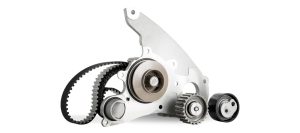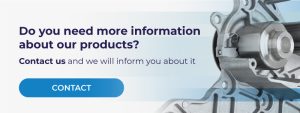The timing belt or toothed belt’s main function is to synchronize the movement of the engine, driving the camshaft of an engine from the crankshaft.
It is one of the most important components of a vehicle. If it is damaged or broken, it can lead to serious damage to the engine, so it is essential to know and check its condition.
In today’s article we answer some common queries about the timing belt service and when the replacement is necessary.
Timing belt or timing chain: what does my car have?
Depending on the kind of car you have, your setup will either have a timing belt or a chain.
The easiest way to find out if your vehicle has a timing chain in its distribution or, on the contrary, your engine is driven by a timing belt, is to check if there is a plastic cover on the side of the engine or not. If so, the engine is fitted with a timing belt. If there is no plastic cover then it has a timing chain.
Although both elements are in constant development, most modern vehicles are now fitted with a timing chain rather than a timing belt. Both perform the same function, connecting the camshaft to the crankshaft, but they differ essentially in their materials.
The chain is made up of small metal links while the timing belt is made of rubber. Hence the chain mechanism is more durable and subject to less wear.
Timing Belt Service Timeline: replacement recommendations
Replacing the belt at the manufacturer’s recommended interval is essential to ensure the engine lifespan. At Dolz we always point that preventive maintenance is a much cheaper job than mandatory maintenance.
If the timing belt drives the water pump, it is 100% recommended not only to replace the timing belt, but also the water pump and other associated parts such as the tensioner, idlers, or pulleys, due to water pump and the timing belt replacements are two of the most common operations in a workshop.
When replacing the timing belt there are some aspects such as belt tension, alignment of timing marks and the associated parts may be unnoticed. Therefore, some of the indications to consider during the replacement are:
- All-inclusive kit.
By purchasing all the necessary parts that you need for the assembly (the timing belt, the pump, the seal, the idlers, the nuts…), you will ensure that all components are perfectly matched to ensure optimum performance.

- Alignment of timing marks.
Be sure to align the timing marks following the original manufacturer’s service recommendations. The proper mesh of the two timing gears assures proper relationships between the valves and pistons.
- Flush the cooling circuit.
Once you have removed and replaced the timing components, all that remains is to flush and refill the cooling system with the right coolant.
It is really important to know that under no circumstances should the engine be started without first filling the circuit, as this ‘dry function’ would cause the elements of the mechanical seal of the water pump to degrade. On the other hand, it is essential that the coolant meets the characteristics required by the manufacturer (otherwise it can directly damage the entire system and the engine).
How to check your timing belt
In general, most timing belts are housed behind protective covers and engine parts, because of this, perform a visual inspection of the belt is not an easy task.
During the visual inspection, first of all, examine the outside of the belt. If you detect that it is frayed, visibly worn or cracked on either side of the belt, it is time to replace it.
Another key point is found in the tension of the belt. If the tensioner fails, certain problems will arise whether the timing belt is too tight or loose, directly affecting the timing service of the crankshaft and camshaft and prematurely wearing the timing belt.
Signs of a worn-out timing belt
In addition to visual inspection, there are some signs to look out for that will help us diagnose a problem with the timing belt. Among the main warning signs are:
- Engine doesn’t start.
- Oil leak under the hood.
- Engine misfires.
- A loss of power or acceleration.
- ‘Ticking’ or squealing sound.
If you notice any of these indicators, it is essential that you go to your trusted workshop as soon as possible to carry out a professional replacement and thus prevent engine damage.
Related content: Unboxing: Timing Belt Kit DOLZ (KD153V)
Dolz Timing Belt Kits, your complete solution
DOLZ Kits have been designed for the most popular applications in Europe, ensuring a professional replacement and providing premium timing belt kits; 100% tested that meet all OEM performance requirements:
- Timing belt: exceptional resistance to abrasion; resulting in extended pulley and belt life and a high resistance to oil and engine heat.
- Idlers: high-quality raw materials and grease to ensure the highest efficiency.
- Water pump: manufactured with a silicon carbide seal. It is designed following the original specifications.
With two options available: kits with the water pump included (KD) and an option without the water pump (SKD), both alternatives are guaranteed for 2 years from date of purchase or 80.000 km.
Still have questions about your timing belt? Our team at Dolz is ready to help you. Contact us for tailored advice on choosing your best option for your timing belt replacement!


